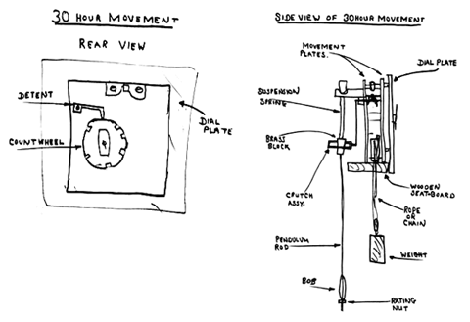Setting Up A Rack-Striking Mantee Clock
The pendulum should have been removed for the journey home and you must refit it. The pendulum consists of a rod with a hook or eye at the top and a bob. Hook the pendulum onto the “hanger”. This part hangs from the movement and often swings back and forth quite freely; but take care not to force it beyond its free travel. It is normal to fit the pendulum with the “best” side of the bob facing where it can be seen. The nut below, or in the centre of, the bob can be screwed up to make the clock go faster or down to make it go slower.
Place the clock on a firm level surface. Check that it cannot wobble and if necessary put a piece of card or folded paper under the appropriate rear foot. Listen to the clock tick – it should have a steady and even tick. If not, lift one end and if the tick is better put some packing under the raised end. If it is worse; lift the other end and when the tick sounds even put the packing under that end. If the clock has been raised so much that it looks odd the clock may need to be adjusted at the workshop.
Your clock is known as an eight-day clock but it should be wound every week i.e. every seven days. It is very beneficial to the clock to wind it fully and keep it running all the time if possible – clocks like to work!
To set clock to the right time turn the minute hand (the long one) CLOCKWISE ONLY – DO NOT MOVE THE LITTLE HAND. You must stop at the strike positions and wait for it to finish striking until you go on to the next position.
If your clock strikes a different number of blows to the time shown it is most likely because the hour (little) hand has been accidentally moved. Turn the minute (long) hand until it reaches the 12. O’clock position & strikes, then turn the hour hand to point to the hour just struck.


